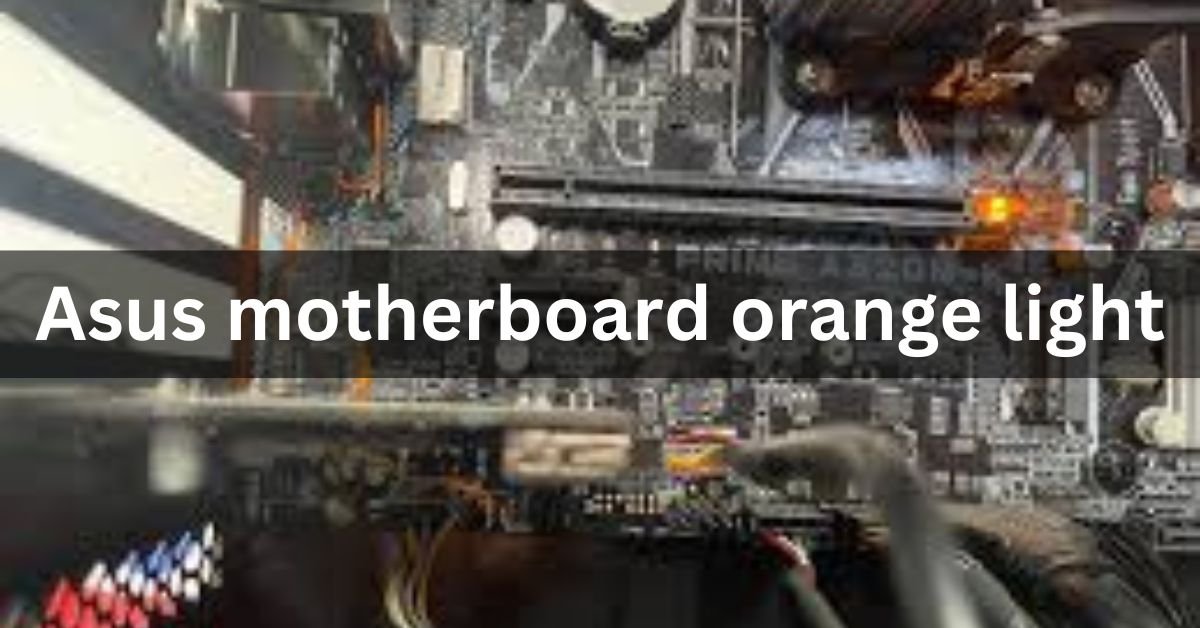Asus motherboards are renowned for their performance and reliability, powering countless computers worldwide. However, encountering an orange light on your Asus motherboard can be a cause for concern.
The orange light on an Asus motherboard often indicates a hardware issue or power supply problem. Check connections and ensure components are properly seated. If the issue persists, consult the motherboard manual or contact Asus support for assistance.
In this article, we will discuss “Asus motherboard orange light”.
Understanding the Orange Light on ASUS Motherboard:
The orange light on an ASUS motherboard typically indicates that there’s standby power reaching the board. This means that even when the computer is turned off, there’s still a small amount of power being supplied to certain components, like the motherboard, to enable features like wake-on-LAN or standby mode.
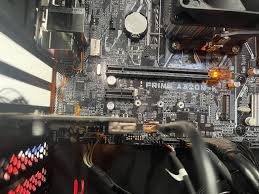
In some cases, the orange light might also indicate a fault or issue with the motherboard, such as a power delivery problem or a component failure.
Common Causes of Asus Motherboard Orange Light
To address the problem effectively, it’s essential to identify its root cause. Here are some common culprits behind the orange glow on your Asus motherboard.
1. Faulty Power Supply:
A malfunctioning power supply unit (PSU) can trigger the orange light. Insufficient power delivery or irregular voltage output may lead to instability in your system.
2. RAM Issues:
Faulty or improperly seated RAM modules can cause the motherboard to display the orange light. Reseating or replacing the RAM sticks might resolve the issue.
3. CPU Problems:
Issues with the central processing unit (CPU), such as overheating or poor connection, can also trigger the orange light. Ensure that the CPU is properly installed and adequately cooled.
4. Overheating:
Excessive heat buildup within the system can activate the orange light as a protective measure. Proper ventilation and cooling solutions are crucial to prevent overheating.
5. BIOS Errors:
Errors or corruption in the BIOS firmware can lead to the motherboard displaying the orange light. Updating or resetting the BIOS might alleviate the problem.
Troubleshooting Steps of ASUS Motherboard Orange Light:
Now that we’ve identified potential causes let’s explore the steps to troubleshoot and resolve the issue.
1. Checking Power Supply:
Verify that the power supply unit is functioning correctly and providing adequate power to all components.
2. Inspecting RAM:
Remove and reseat the RAM modules, ensuring they are securely installed in their slots.
3. Examining CPU:
Check the CPU for any signs of damage or overheating. Ensure that the CPU cooler is properly attached and functioning.
4. Monitoring Temperature:
Utilize monitoring software to track the temperature of critical components and take measures to reduce heat buildup if necessary.
5. Updating BIOS:
If BIOS errors are suspected, consider updating or resetting the BIOS to resolve any potential issues.
Asus Motherboard Solid Orange Light No Boot?
If your Asus motherboard has a solid orange light and won’t boot, it could indicate issues with the power supply, RAM, or CPU.
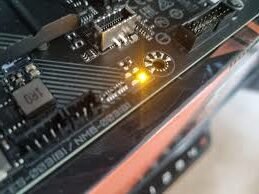
Check connections, ensure components are properly seated, and try booting with minimal hardware to isolate the problem.
Asus Motherboard Orange Light Reset?
To reset the orange light on your Asus motherboard, first, power off your computer. Then, unplug the power cable and remove the CMOS battery from the motherboard for a few minutes. Reinsert the battery and reconnect power to reset the motherboard’s settings.
Asus Motherboard Orange Light No Display?
If your Asus motherboard has an orange light and no display, it could indicate a problem with your graphics card, monitor connection, or BIOS settings.
Check connections and try reseating components. If the issue persists, consult your motherboard manual or seek technical support.
Asus Motherboard Light Codes?
Asus motherboards often have diagnostic LED lights that indicate various system statuses or errors.
Refer to your motherboard’s manual to interpret these light codes. They can help identify hardware problems like CPU or RAM issues, aiding in troubleshooting and resolving issues.
Asus Motherboard Orange Light Not Working?
If the orange light on your Asus motherboard isn’t working, it might indicate a power or connection issue.
Check the power source and connections. If everything seems fine, there could be a problem with the LED itself, requiring professional repair or replacement.
Asus Motherboard Orange Light Flashing?
If the orange light on your Asus motherboard is flashing, it typically indicates a hardware issue. Check your RAM sticks first to ensure they’re properly installed.
If the problem persists, consult your motherboard manual or contact Asus support for further assistance.
Dram Light On Motherboard Orange?
The orange light on your motherboard usually indicates a problem with your computer’s DRAM (memory).
Check that your RAM sticks are properly seated in their slots. If the issue persists, one of the sticks might be faulty and needs replacement.
Motherboard DRAM Orange Light Issues:
If the motherboard’s DRAM orange light is on, it indicates a problem with the memory. Try reseating the RAM sticks firmly in their slots, or if that fails, test each stick individually to identify the faulty one.
ROG Strix B350-F Gaming, Orange Light?
The orange light on the ROG Strix B350-F Gaming motherboard may indicate a power or hardware issue.
Check connections and ensure components are seated correctly. If the problem persists, refer to the motherboard manual or seek technical support.
What Is Orange Light on Motherboard?
The orange light on a motherboard typically indicates a power-related issue or hardware problem. It serves as a warning signal to alert users to potential issues with the power supply, connections, or components.
How to Fix Orange Light on Motherboard?
An orange light on your motherboard typically indicates a problem with power delivery or system health. Here’s a step-by-step guide to troubleshoot and potentially fix this issue:
1. Check Power Supply Unit (PSU):
Ensure that the PSU is correctly connected to the motherboard and that all power cables are securely plugged in. Sometimes, loose connections can cause power-related issues.
2. Inspect Power Button Connection:
Make sure the power button on your case is properly connected to the motherboard. Faulty connections here can prevent the system from booting up correctly.
3. Reset CMOS:
Resetting the CMOS (Complementary Metal-Oxide-Semiconductor) can sometimes resolve power-related issues. Refer to your motherboard manual for instructions on how to reset the CMOS.
4. Test with Minimal Hardware:
Disconnect all unnecessary peripherals and expansion cards from the motherboard, leaving only the essential components such as CPU, RAM, and GPU (if required). Then, try powering on the system again.
5. Check RAM:
Faulty or improperly seated RAM modules can cause booting problems. Try reseating your RAM sticks in their slots or test them one at a time to identify any faulty modules.
6. Inspect CPU and Cooler:
Ensure that the CPU is properly installed and that the cooler is securely attached. Overheating can cause the system to shut down or fail to boot properly.
7. Check for Visual Damage:
Inspect the motherboard for any signs of physical damage, such as burnt components or bulging capacitors. If you find any, it’s likely that the motherboard needs to be replaced.
8. Update BIOS:
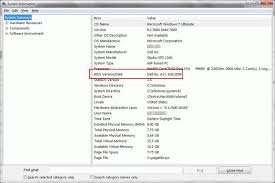
In some cases, updating the motherboard BIOS to the latest version can resolve compatibility issues and improve stability. However, be cautious when updating BIOS, as a failed update can potentially brick your motherboard.
9. Test with Known Good Components:
If possible, try substituting known good components (such as a different PSU, RAM, or CPU) to isolate the source of the problem.
10. Consult Manufacturer Support:
If none of the above steps resolve the issue, it’s advisable to contact the manufacturer’s technical support for further assistance. They may provide additional troubleshooting steps or recommend sending the motherboard for repair or replacement.
Motherboard stuck at orange light?
If your motherboard is stuck at an orange light, it likely indicates a power-related issue or hardware problem.
Check connections, power supply, and ensure components are properly seated. If the issue persists, seek technical assistance.
What is an OH LED in a motherboard?
An OH LED on a motherboard typically refers to an Overheat LED, indicating that the motherboard is detecting high temperatures in certain components. It serves as a warning to prevent potential damage.
Why does my ASUS laptop power light blink green then orange constantly?
Your ASUS laptop power light blinking green then orange constantly may indicate a battery charging problem. Check the power adapter and battery connections. If the issue persists, it could be a battery or charger malfunction. Consider contacting ASUS support.
Solid orange DRAM light on, mouse/keyboard unresponsive:
A solid orange DRAM light on your motherboard with unresponsive mouse and keyboard suggests a RAM (memory) issue.
Try reseating the RAM modules or using different slots. If the problem persists, consider testing the RAM or seeking technical support.
Read: Are Gigabyte Motherboards Good – Ultimate Guide – 2024
What does an orange light mean on ASUS motherboard?
An orange light on an ASUS motherboard often indicates a power-related problem, such as issues with the power supply, connections, or hardware. Check these areas and consult the motherboard manual for troubleshooting guidance if needed.
Read: Can Motherboards Bottleneck – The Ultimate Guide of 2024!
What does orange PC light mean?
An orange light on a PC typically indicates a hardware or power-related issue. It could signify problems with the power supply, motherboard, or components. Refer to the PC’s manual or seek technical support for troubleshooting assistance.
Read: Do Motherboards Come With Bluetooth – Complete Guide – 2024!
Why is the yellow light on my ASUS motherboard?
A yellow light on your ASUS motherboard may indicate various issues, such as power supply problems, hardware malfunctions, or system errors. Consult the motherboard manual or contact ASUS support for troubleshooting assistance.
Read: Do Motherboards Come With Screws – Ultimate Guide – 2024
Why is the orange light on my motherboard not blinking?
If the orange light on your motherboard is not blinking, it may indicate a stable power supply or a potential issue with the LED itself. Check connections and consult the motherboard manual for troubleshooting guidance.
Read: New Motherboard Wifi Not Working – Ultimate Guide – 2024
Orange Light on Motherboard?
An orange light on a motherboard usually signals a problem with power or hardware. Check connections and ensure components are properly seated. If unsure, consult the motherboard manual or contact technical support for assistance.
Read: Can Old Motherboard Support New GPU – Ultimate Guide – 2024
X570 blinking orange light?
A blinking orange light on an X570 motherboard could indicate power or hardware issues. Check connections and component seating. If the problem persists, consult the motherboard manual or contact technical support for assistance.
Read: Should I Connect HDMI to GPU or Motherboard – Complete Guide!
My ASUS laptop battery light is blinking orange. How do I fix it?
If the battery light on your ASUS laptop is blinking orange, it may indicate a charging or battery problem. Try unplugging and reconnecting the charger, or restart your laptop. If the issue persists, consult ASUS support for assistance.
Read: Do Motherboards Have Bluetooth – Ultimate Guide – 2024
What can cause an orange blinking light on a gaming PC motherboard?
An orange blinking light on a gaming PC motherboard can indicate power supply issues, faulty connections, or hardware malfunctions.
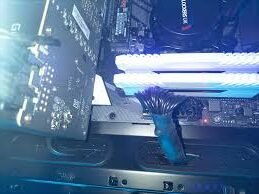
Check power connections and components for proper seating. Refer to the motherboard manual or seek technical support for further troubleshooting.
Read: What Is T Sensor On Motherboard – Complete Guide – 2024
FAQs:
1. What does it mean by an Asus motherboard orange LED light blinking? Are there any issues on the motherboard?
If the orange LED light on your Asus motherboard is blinking, it could indicate hardware issues or power problems. Check connections and component seating. If unsure, consult the motherboard manual or contact Asus support for assistance.
2. Why is my Asus motherboard flashing orange?
A flashing orange light on your Asus motherboard may indicate a power or hardware issue. Check connections and ensure components are properly seated. If the problem persists, consult the motherboard manual or contact Asus support for assistance.
3. What does orange light on a motherboard mean?
An orange light on a motherboard usually indicates a problem with power or hardware. It could suggest issues with the power supply, connections, or faulty components. Consult the motherboard manual or seek technical support for troubleshooting assistance.
4. What does a solid orange light mean on ASUS motherboards?
A solid orange light on ASUS motherboards typically indicates a power-related problem. It could be due to issues with the power supply, connections, or components. Check these areas first, and consult ASUS support if needed for further assistance.
5. Why is there an orange light on the bottom left of an ASUS motherboard? Nothing will turn on.
An orange light on the bottom left of an ASUS motherboard indicates a power issue. Check connections and ensure the power supply is functioning correctly. If nothing turns on, it may require professional inspection or assistance from ASUS support.
6. Why is there a flashing yellow light on my ASUS motherboard and my PC won’t boot up?
A flashing yellow light on your ASUS motherboard suggests a hardware problem, potentially with power supply or components. Check connections and ensure everything is properly seated. If the issue persists, seek assistance from ASUS support.
7. What is the function of the audio LED in my motherboard?
The audio LED on your motherboard typically indicates the status of the onboard audio system. It may light up when audio is being played or to signal errors. Refer to your motherboard manual for specific details.
8. What does it mean if the lights on the motherboard are flashing?
Flashing lights on a motherboard may indicate a hardware issue, such as faulty components or improper connections. Consult the motherboard manual for troubleshooting guidance, or seek assistance from technical support if necessary.
9. My monitor LED is blinking. Is it a motherboard or CPU issue?
A blinking LED on your monitor typically suggests a display problem rather than issues with the motherboard or CPU. Check monitor connections and settings first, then consult manufacturer resources for troubleshooting steps if needed.
10. What is orange light on a motherboard?
The orange light on a motherboard usually signals a hardware problem or power issue. It could indicate faulty connections or components. Refer to the motherboard manual for troubleshooting steps, or seek assistance from the manufacturer’s support team for further guidance.
Conclusion:
In conclusion, an orange light on an ASUS motherboard often indicates power-related issues or hardware problems. This guide highlights common causes, troubleshooting steps, and potential solutions to address the issue. By checking connections, ensuring proper component seating, and following the outlined steps, users can effectively troubleshoot and resolve orange light issues on their ASUS motherboards.
